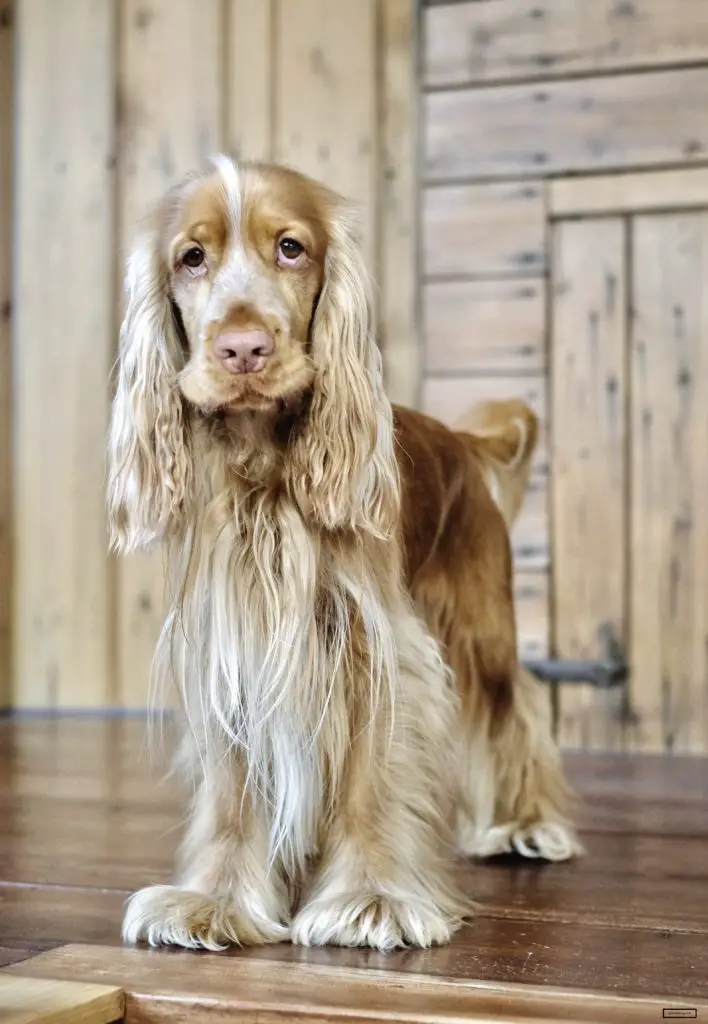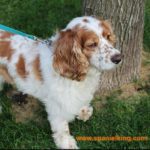The English Cocker Spaniel is a type of gun dog that originated in England.
It is notable for generating one of the most diverse amounts of pups in a litter of any dog breed when compared to other breeds.
When it comes to sports, the English Cocker Spaniel is a high-energy, good-natured dog that stands well up at the withers and is compactly constructed.
There are two types of cockers: “field” cockers who labor in the field and “house” cockers.
It is one of several spaniel variants, and it is the ancestor of the American Cocker Spaniel, which is a close relative of the English breed.
This breed of puppy is more closely related to the working-dog forms of the Field Spaniel and the English Springer Spaniel puppy than the English Cocker Spaniel puppy.
Outside of the United States, the breed is commonly referred to as the Cocker Spaniel, whereas the American Cocker Spaniel is the name given to the breed in the United States.
The word cocker is widely believed to have originated from their use in woodcock hunting.
The breed can produce litters ranging in size from three to twelve puppies like any other huge breeds like the german shepherd and labrador retriever.

Related Articles:
How Much Do Cocker Spaniels Shed? [Answered]
Table of Contents
What is the color of the sable in a cocker spaniel?
When it comes to spaniels, sable is an uncommon hue.
It is a rare color for your spaniel cocker even it is a separate breed.
A mixture of red and yellow hair with black or black-banded hairs is the cause of this condition.
History
Spaniels have appeared in art and literature for about 500 years.
In England, spaniels were initially separated into two types:
- Land spaniels
- Water spaniels
It wasn’t until the mid-nineteenth century that spaniels began to be separated into the breeds we see today like an english springer spaniel and a charles spaniel.
Over time, the land spaniels became more specialized, and weight categories were established among the many breeds of land spaniels.
Cockers weighed 12–20 lb (5.5–9 kg) according to the 1840 Encyclopedia of Rural Sports.
It was fairly uncommon for Cockers and Springers to be born in the same litter at the time.
Springers are capable of maturing from any lineage, including those from “Toy” bloodline dogs.
According to these early accounts, there is no proof that spaniels were used to recover wildlife.
Instead, they were used to draw game closer to the cannons so that they could be shot.
Field Spaniel
With the rise in popularity of dog shows in the late nineteenth century, as well as the establishment of breed standards for individual breeds, the Spaniel family began to split into a number of distinct sub-species.
A group of dog enthusiasts came up with the idea of developing a huge black spaniel breed.
Initially, only four dogs would serve as the progenitors for this dog breed, two of which were Cocker Spaniels, one of which was an offspring of a Cocker Spaniel and a mix of a Cocker Spaniel and an English Water Spaniel, and one of which was a Norfolk Spaniel, which is a distinct breed in its own right.
It was not until 1892 that the Kennel Club formally recognized the Field Spaniel as a breed, and it was then that the dog was given the name Field Spaniel.
The American Cocker Spaniel is a dog breed that has its origins in the United States of America.
English Cocker Spaniel
The American Cocker Spaniel was developed from the English Cocker Spaniel in the nineteenth century for the purpose of retrieving quail and woodcock.
They were originally separated from the English Cocker simply on the grounds of size, but they have since been bred by a dog breeder for a variety of different characteristics.
The English Cocker Spaniel and the American Cocker Spaniel were displayed together in America until 1936, when the English Cocker Spaniel was granted independent breed recognition by english cocker spaniel club.
After much debate about the breeding and the breed standard, the English Cocker Spaniel was officially recognized as a distinct breed by the American Kennel Club in 1946.
Compared to the English Cocker, the American Cocker has a shorter snout and is more prone to ear infections, as well as being groomed in a different manner.
What Exactly Is A Sable Cocker Spaniel?
In spaniels, sable is a unique colour or much like to be called a sable pattern.
Unlike any other spaniel dogs like the cavalier king charles spaniel or the blue merle.
This type of dog breed has a blend of color red and yellow hair with black or black-banded hairs causes it and make it as a designer dogs.
What Hue Does Sable Fur Come In?
The color of sable skin ranges from pale brown to dark brown.
Sables have a hierarchy, just like any other fur.
Barguzinsky dark hue with gray hairs is the most expensive sable.
What Distinguishes A Sable dog?
What Does a Sable Dog Coat Look Like?
The ombre look of the sable coat pattern is beautiful, since the hair shaft is lighter at the base and darkens towards the tip.
The sable gene is dominant, which means that only one sable gene is required to color a dog.
Is Crimson Cocker Spaniels Are Uncommon?
Cocker spaniels come in a variety of colors.
Within the Cocker breed, there are several acceptable but extremely restricted color varieties:
- Black
- With tan points
- Parti-color
- Any Solid Color Other than Black
Cocker spaniels come in a variety of colors.
In Cocker Spaniels, What Does Sable Mean?
It varies greatly between breeds; the crucial thing to remember is that the hair on a dog’s body is lighter at the base than at the tip.
In the United States, the term sable refers to black canines with lighter hair at the root.
Spaniel Dog Health Problems
The following are examples of unusual health problems that can affect English Cocker Spaniels:
- Canine hip dysplasia
- The Patellar luxation
- Canine dilated cardiomyopathy, and
- The Heart murmurs
Hip dysplasia is an abnormal formation of the hip joint that is the most prevalent cause of canine arthritis in the hips.
It is also the most common cause of canine arthritis in the knees.
Patellar Lunation, also known as luxating patella, is a condition in which the kneecap dislocates from its socket.
When the heart muscle becomes weak and does not contract properly, canine dilated cardiomyopathy develops.
It is an adult-onset illness that affects dogs.
It can result in congestive heart failure, which is characterized by the accumulation of fluid in the lungs, chest, abdominal cavities, or beneath the surface of the skin especially if it is a rescue dog.
Dilated cardiomyopathy is frequently accompanied by irregular cardiac rhythms, sometimes known as arrhythmias, which can make treatment more difficult.
Cocker Spaniels can develop a nutritional form of dilated cardiomyopathy, which is connected with low blood concentrations of the amino acid taurine, when they are overweight.
This type of dilated cardiomyopathy is often reversible if the dog receives taurine supplementation during the treatment period.
Frequently Asked Questions (FAQ)
The average lifespan of the American Cocker Spaniel breed is between 12 and 15 years. Progressive retinal atrophy (PRA), cataracts, patellar luxation, and glaucoma are only a few of the major health complications associated with the disease. Diseases such as elbow dysplasia, stomach torsion, and epilepsy might affect the breed on occasion, according to the ASPCA.
Because of their floppy ears, they appear to be one of the most innocent-looking dog breeds, but according to a new study,
English cocker spaniels are really among the most violent canines on the planet.
The golden types and males of the English cocker spaniels were determined to be the most aggressive, as were the males.
Their colors might range from dark to chocolate to golden to silver-looking. S
able pups are frequently extremely similar in color to “acceptable” colors, and the coat changes occur gradually and after the pup is handstripped, as shown in the photo.




![Simple Facts English Cocker Spaniels [2022] Simple Facts English Cocker Spaniels [2022]](https://spanielking.com/wp-content/uploads/2022/02/Cocker-Spaniel-English-Gold-Doggy-Dog-Puppy-2414185-150x150.jpg)
![American Water Spaniel Vs Boykin [The Difference] American Water Spaniel Vs Boykin [The Difference]](https://spanielking.com/wp-content/uploads/2021/12/Cocker-150x150.jpg)